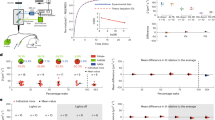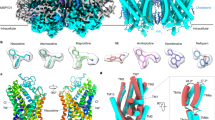Abstract
THE sexual differentiation of gonadotropin secretion1 and female sexual behaviour2 occurs in the rat hypothalamus5 during the early postnatal period and is produced by testicular androgen in the male, although it may be mimicked in the female by administration of oestrogen or androgen3. The mechanism of this neural differentiation probably involves the aromatisation of testicular androgen to oestrogen in the hypothalamus4, followed by a complex series of biochemical events contingent on the binding of this oestrogen to a receptor and the trans-location of the steroid-receptor complex to the nucleus. Cytosol oestrogen receptors6–8 and aromatising enzymes4 have been demonstrated in the neonatal brain; aromatising enzymes are localised to the differentiating areas4 whereas oestrogen receptors are found throughout the forebrain6,7. In the study reported here, we have measured the nuclear oestrogen receptor in the neonatal brain using a nuclear exchange assay9 and have found that its distribution is consistent with the postulated role of the oestrogen receptor in the sexual differentiation of the brain.
This is a preview of subscription content, access via your institution
Access options
Subscribe to this journal
Receive 51 print issues and online access
$199.00 per year
only $3.90 per issue
Buy this article
- Purchase on Springer Link
- Instant access to full article PDF
Prices may be subject to local taxes which are calculated during checkout
Similar content being viewed by others
References
Harris, G. W., Endocrinology, 75, 627–648 (1964).
Beach, F. A., in Biopsychology of Development (edit. by Tobach, E., Aronson, L. R., and Shaw, E.), 249–296 (Academic, New York, 1971).
Gorski, R. A., in Frontiers in Neuroendocrinology (edit. by Martini, L., and Ganong, W. F.), 237–290 (Oxford University Press, New York, 1971).
Reddy, V. V. R., Naftolin, F., and Ryan, K. J., Endocrinology, 94, 117–121 (1974).
Barraclough, C. A., and Gorski, R. A., Endocrinology, 68, 68–79 (1961).
Barley, J., Ginsburg, M., Greenstein, B. D., McLusky, N. J., and Thomas, P. J., Nature, 252, 259–260 (1974).
Salaman, D. F., Thomas, P. J., and Westley, B. R., Ann. Biol. biochem. biophys. (in the press).
Fox, T. O., Nature, 258, 441–444 (1975).
Anderson, J., Clark, J. H., and Peck, E. J., Jr, Biochem. J., 126, 561–567 (1972).
Scatchard, G., Ann. N.Y. Acad. Sci., 51, 660–672 (1949).
Burton, K., Biochem. J., 62, 315–323 (1956).
Plapinger, L., and McEwen, B. S., Endocrinology, 93, 1119–1128 (1973).
Jensen, E. V., and Desombre, E. R., A. Rev. Biochem., 41, 203–230 (1972).
Westley, B. R., and Salaman, D. F., Brain Res. (in the press).
Lieberburg, I., and McEwen, B. S., Brain Res., 85, 165–170 (1975).
Meijs-Roelofs, H. M. A., Uilenbroek, J. T. J., De Jong, F. H., and Welschen, R., J. Endocr., 59, 295–304 (1973).
McEwen, B. S., Plapinger, L., Chaptal, C., Gerlach, J., and Wallach, G., Brain Res., 96, 400–406 (1975).
Author information
Authors and Affiliations
Rights and permissions
About this article
Cite this article
WESTLEY, B., SALAMAN, D. Role of oestrogen receptor in androgen-induced sexual differentiation of the brain. Nature 262, 407–408 (1976). https://doi.org/10.1038/262407a0
Received:
Accepted:
Published:
Issue Date:
DOI: https://doi.org/10.1038/262407a0
This article is cited by
-
Effect of an inhibitor of aromatization, 1,4,6 androstatriene-3,17-dione (ATD) on LH release and steroid binding in hypothalamus of adult female rats
Experimental Brain Research (1986)
-
Sexual differentiation of the brain
Nature (1981)
Comments
By submitting a comment you agree to abide by our Terms and Community Guidelines. If you find something abusive or that does not comply with our terms or guidelines please flag it as inappropriate.



